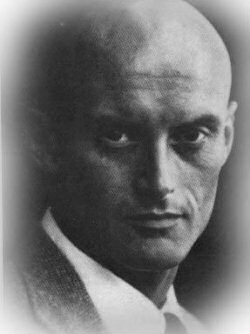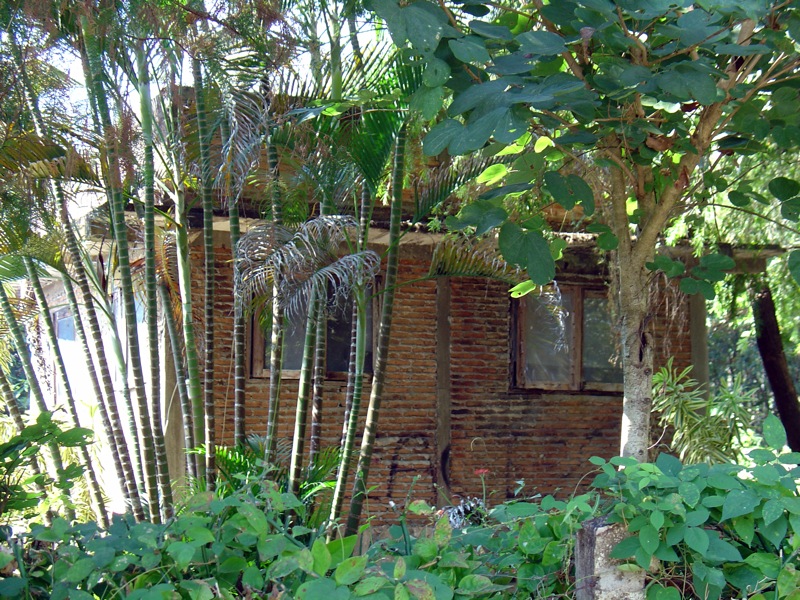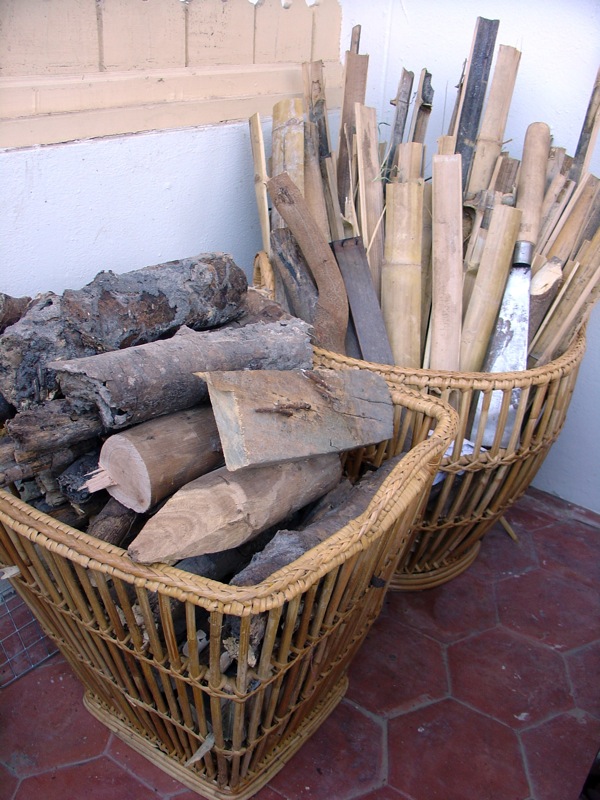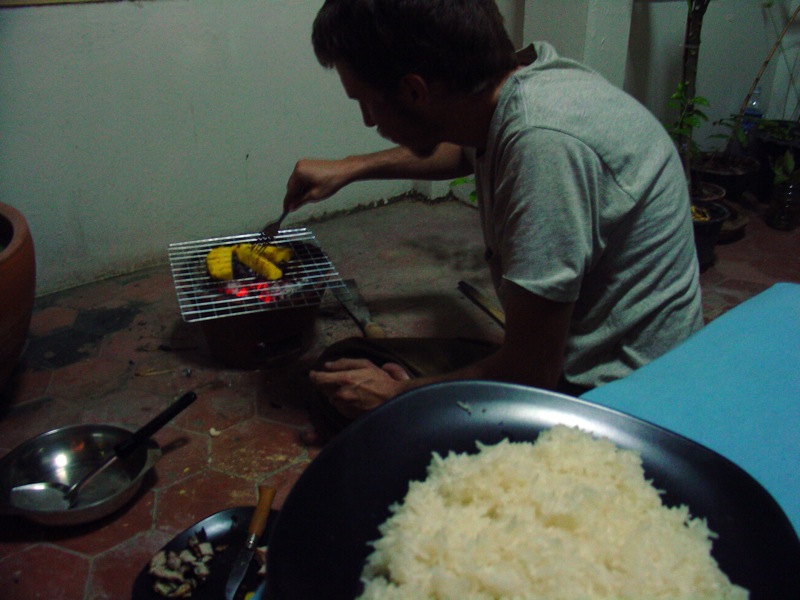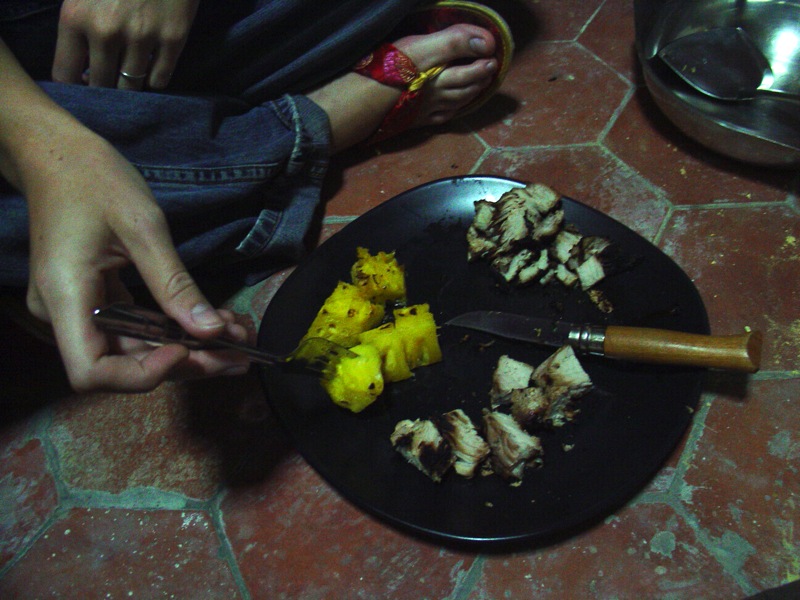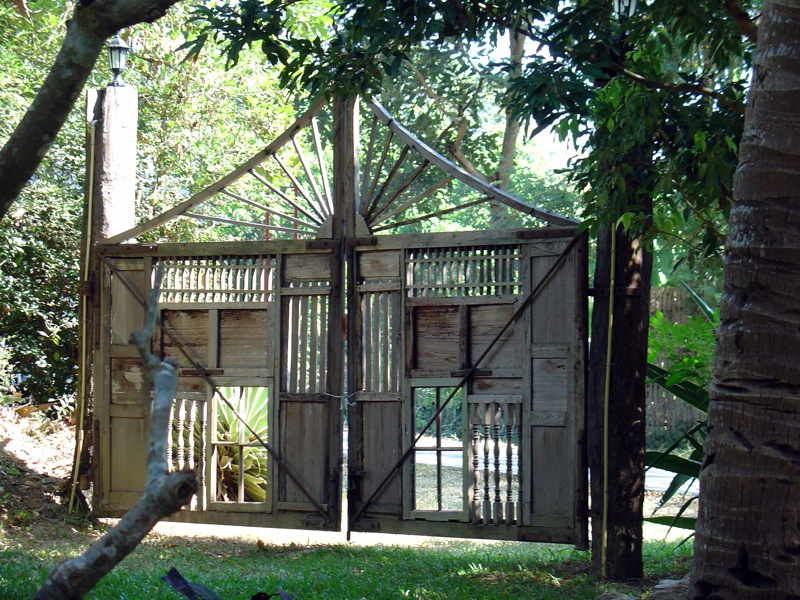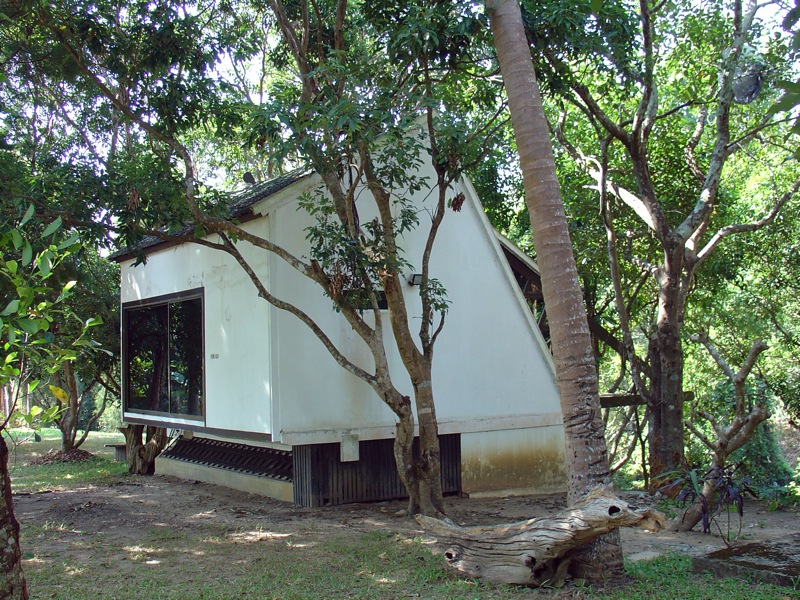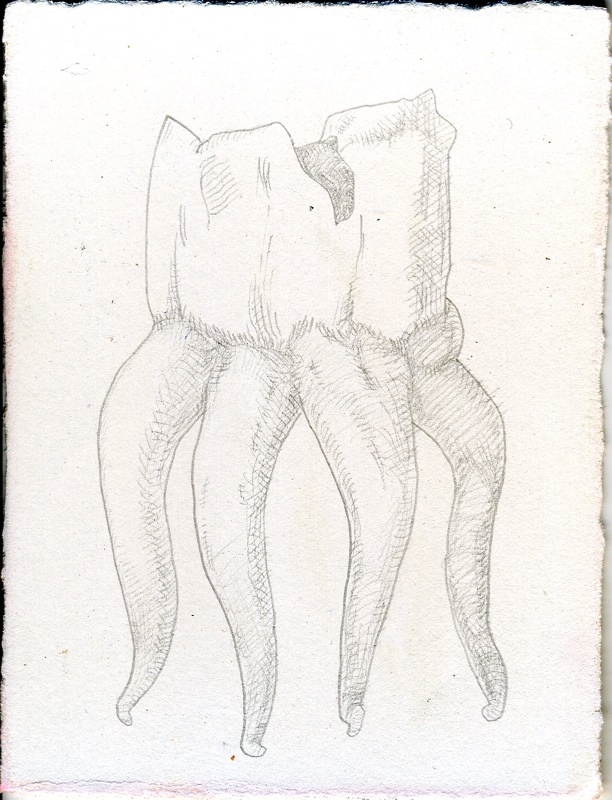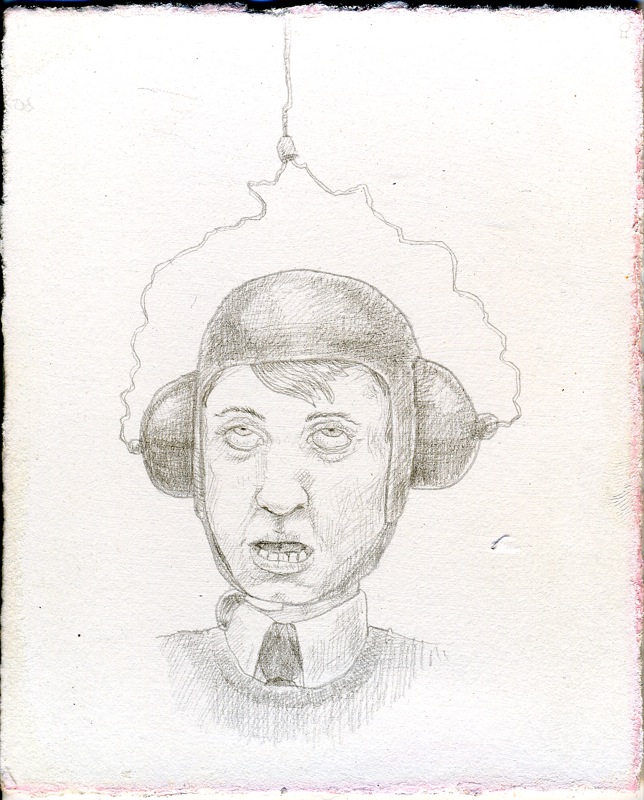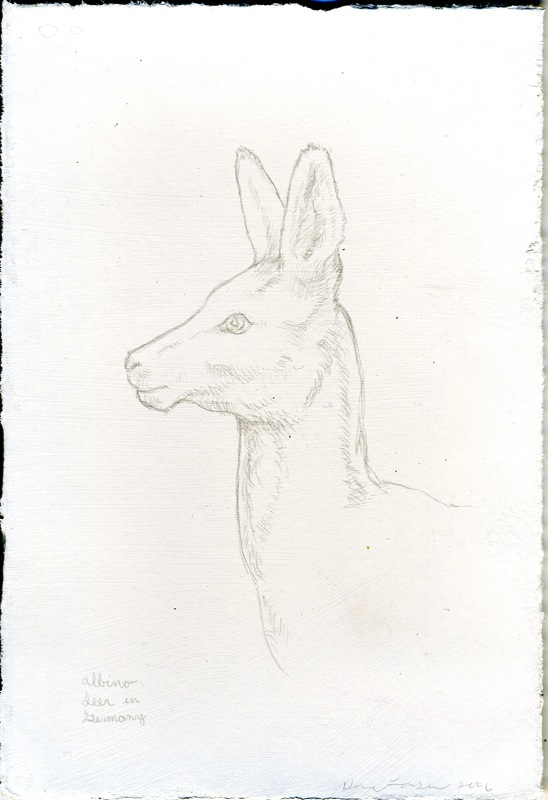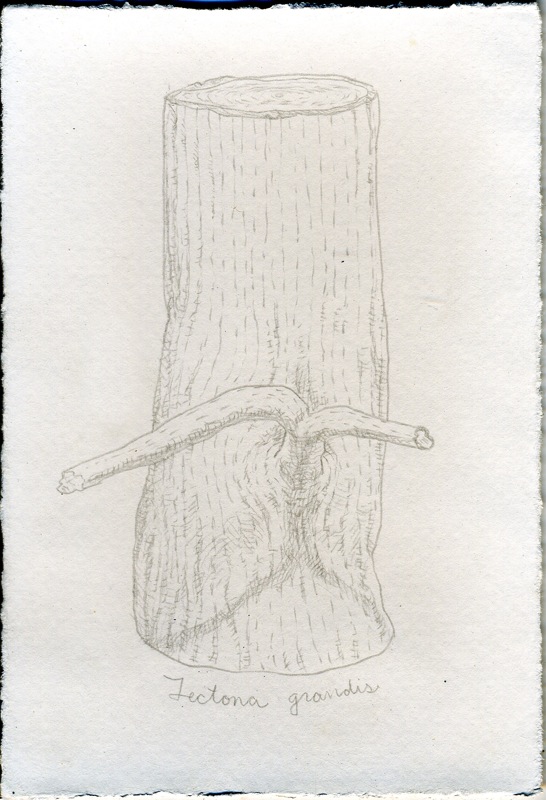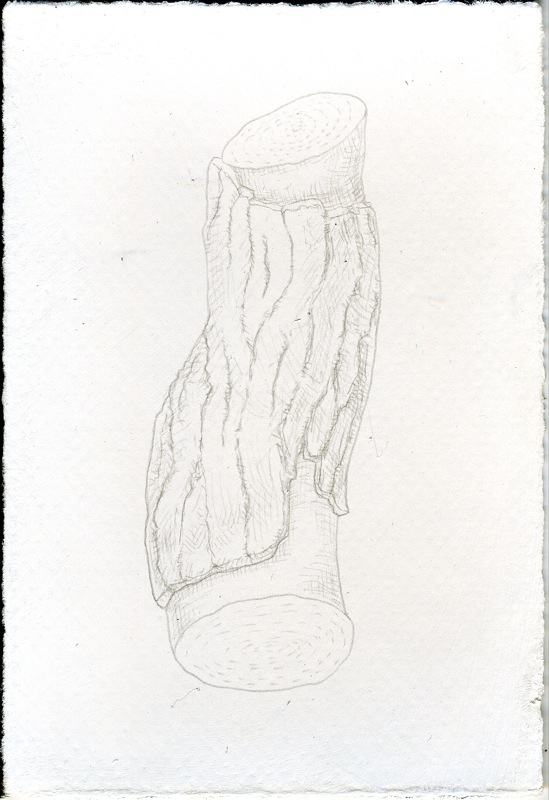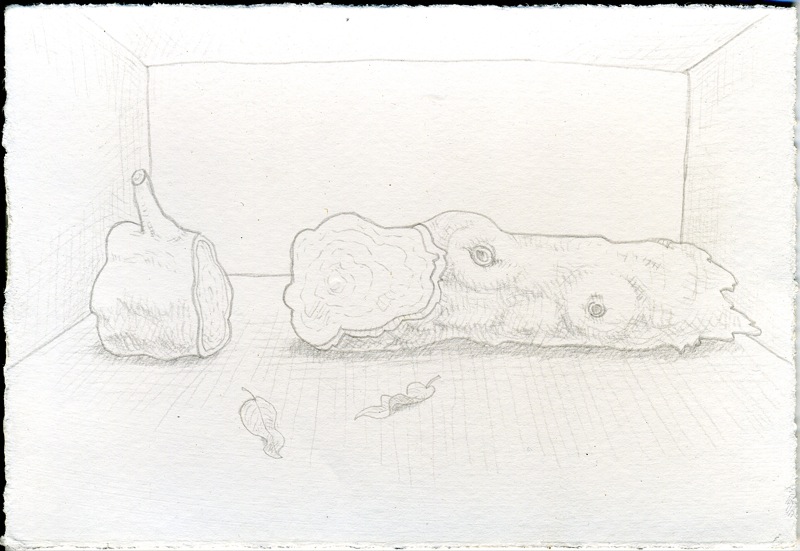31 December 2006
30 December 2006
Three Supplanters, or Heirs Apparent?
Key to each of the post-Postmodernist approaches (and thus we see the absurd depths to which vocabulary regarding the subject can descend) is some sort of idea of wholeness. For Eshelman it is the wholeness of the ostensive, or originary scene, and, likewise, the restored wholeness of the subject. Wholeness and integration are evidences of psychological/spiritual maturity for Wilber, and the holons and holarchies of Arthur Koestler's version of systems theory are an important part of his vocabulary. Alexander lays the groundwork for a mathematical definition of “the wholeness,” that is, an identifiable system of centers. His conception of wholeness is somewhat analogous to a holarchy, but only superficially.
In his essays “Performatism, or the End of Postmodernism,” and “Performatism in Architecture, On Framing and the Spatial Realization of Ostensivity,” Eshelman relies heavily on Eric Gans’s concepts of the ostensive and the originary scene. According to Gans’s theory, as hominid, or "proto-human" groups became increasingly social they began to engage in mimesis to an ever-greater degree. This is borne out in brain research, with higher primates having a larger number of mirror neurons. Mirror neurons, at least as far as I have been led to understand, fire in response to the observation of another’s actions. That is to say, as you pick up a cup, a number of neurons will fire while you are having the experience of picking up the cup. If you watch me pick up a cup the same group of neurons will fire. You will have the experience of having picked up the cup vicariously through me, your mirror neurons mirroring, or mimicking my actions. In Gans’s theory this tendency to mimesis among early hominids began to lead to what he and Rene Girard call mimetic desire, something every parent is familiar with as children fight over the same toy, or dinner goers to whom their companion’s meal always looks more appetizing. This mimetic desire eventually (probably quite often) culminated in a scene of mimetic violence, until one fine day in the Great Rift Valley in Eastern Africa a troop of hairy, hungry hominids was gathered around a prey item. They were all hungry, of course, and all desired to eat said prey item. As they observed the desire of their comrades, their mirror neurons began to fire. They desired, and saw each other desiring, and saw that the other also saw one’s own desiring. Whoever made the first move would probably get killed. No one wanted to die, just to eat, and as each one looked around they saw that the others likewise did not wish to die. Suddenly one of these hungry proto-humans made a sign, a gesture, a vocalization, who knows, but a sign nonetheless designating the prey item with a “deferred gesture of appropriation,” according to Gans. This action, understood and accepted by the rest of the group, became the first ostensive sign, and violence was thereby deferred. Meanwhile, the sign and its thing, the prey item, became inextricably bound, and together took on the aura of the sacred, as the first humans, proto no longer, stood in awe of its power. “In the beginning was the Word, and the Word was with God, and the Word was God,” writes John. The original, ostensive sign was fetsihized, was designated the “name-of-God,” and its thing, devoured in an act of sparagmos, became the first sacrifice to God. Thus the groundwork was laid for all the rest of human culture.
Performatism, Eshelman’s term for the post-Postmodern epoch, returns the sign and its thing to the wholeness of the originary scene through evocation of the ostensive. When the first sign was born it was bound inextricably to the thing it designated, and both were locked inside the frame of the human. This does not mean the human frame/human body, but a conceptual frame encompassing what is required for a proto-human to be human. As layers of culture have been built upon this original sign/thing ostensive event the relation of signifier to signified has become less clear. Why else would I have to clarify that “the frame of the human” does not mean “the human frame?” There is a sign for almost everything known to man, and more for some. There are signs for things that are not or cannot be. Some signs do double, triple, even quadruple duty and more as languages change and flow and meanings get stuck in little eddies as their words continue to rush toward future meanings. This situation has lead some theorists to assert that signs have no meaning, that indeed “meaning is fascist.” I oversimplify, but my point here is not to explain Postmodernism, and DeMan's students serve adequately as an illustrative extreme. As Eshelman explains it, during the Postmodern epoch the frame in which sign and thing are bound was ignored or discarded altogether, allowing both to fly free. Performatism intends to restore the frame. Eshelman claims that this is not an act of restorative nostalgia, the originary scene is lost to history and it is impossible to return to it.
In “Performatism and Architecture,” Performatism is defined as an “epoch in which subject, sign, and thing come together in ways that create an aesthetic experience of transcendency.” This is achieved, primarily, through two means: framing, and the reduction of subjectivity. In the performatist act a secondary yet imperfect frame is established within the bounds of the human. This secondary frame isolates an ostensive, or “idiotic” sign-frame, practically devoid of content, a stand-in for the original prey item and its designating sign. This framing and reduction of subjectivity by emptying the sign-frame of content enables transcendency, which Eshelman defines as two things: “the fictional representation of successful performances, on the one hand, and a phenomenology, an act of experiencing on the other.” Thus, when Ricky Fitts in American Beauty (Eshelman’s favorite example, and a movie Ken Wilber would no doubt appreciate for its Buddhist subtext, as dicussed in Alan Ball's 14 December 1999 interview with Terry Gross) videotapes a white plastic bag dancing in the wind we feel along with him that there really is a benevolent force behind it all. Or at least we feel that he feels it, experiencing, as we do “belief as an aesthetic fact.” We do not have to believe as he believes, but we do need to know that he believes, that God or something of that nature speaks from twirling bags, or bushes that burn and are not consumed. We see the act of transcendency performed successfully, and our mirror neurons fire in response.
The magic here, at least in regards to Postmodernism, is not so much the quasi-mystical experience of transcendency, but the healing of the sign and its thing. It is a bit of a leap at this point, but suffice it to say this arrangement embodies many of the principals Christopher Alexander regards as necessary for a living system: levels of scale, strong centers, boundaries, alternating repetition, positive space, local symmetries, deep interlock and ambiguity, contrast, roughness, echoes, the void, simplicity and inner calm, and not-separateness. For example, Alexander’s definition for the void reads, “the intensity of every center depends on the existence of a still place—an empty center somewhere in its field.” This corresponds nicely to the kenosis of the “idiotic” sign-frame during the ostensive performatist act. A point by point correspondence between the performatist act and Alexander’s fifteen properties of living systems will be given later, once his unique vocabulary has been discussed to the extent possible in what is supposed to be a short essay.
A Theory of Everything is a brief introductory tract to Ken Wilber’s eclectic synthesis of systems theory, spiral dynamics, evolutionary psychology, and Madhyamaka Buddhism. Others, better informed and more qualified than I, have assessed and critiqued Wilber’s project (he famously told one such critic to “simply suck [his] dick”), so I will limit myself here to his claims as they relate to Postmodernism. The bulk of the text relies on Donald Beck and Chris Cowan’s psychological theory of Spiral Dynamics, which builds upon the work of psychologist Clare Graves, with Wilber’s own four-quadrant system superimposed on top. Spiral Dynamics divides human psychological development into several color-coded stages or memes (an unfortunate misuse of Richard Dawkins's term). Each of these memes is a necessary stage through which a person must pass in order to progress to the next. Briefly they are: Beige, corresponding to the most basic level of psychological development necessary for survival of the organism, which they term Instinctual-Archaic; Purple, or Animistic-Tribal, this is the magic world view, and is the necessary minimum for primitive human society; Red, or Egocentric-Dominionist, corresponding to the rise of nations, and ethnicities, and the terrible-twos; Blue, or Absolutistic, this is the stage in which adherents to fundamentalist religious convictions find themselves, also most teens and preteens; Orange, Multiplistic-Scientific-Rationalist, this is the stage that corresponds to the Enlightenment, positivism, Modernism, the rise of human rights, atheism, capitalism, a number of healthy and unhealthy expressions; Green, or Relativistic-Personalistic, this is the meme responsible for cultural relativism, Postmodernism, and the fierce egalitarianism that has brought us political-correctness; Yellow, Systemic-Integrative, the first of what are called the second-tier memes, yellow is quite rare, and is characterized by a realization that the world is made of many intimately linked and balanced systems, both vertically and laterally; Turquoise, or Holistic brings emotional depth to the realizations of Yellow; Coral is so rare that there are too few individuals in that stage to study it in depth, Wilber is fond of calling it Psychic. On top of this system of Spiral Dynamic memes Wilber has superimposed a four-quadrant system of I, We, and the two Its (lead vocals, lead guitar, bassist/drummer). In the upper left quadrant is the I, meaning the self and consciousness. In the upper right is the I’s It, or the brain and body. The lower left quadrant is We, meaning a culture and its world view. The lower right is Our It, or social systems and environment. To top it all off this system is conceived in terms of Arthur Koestler's version of systems theory including his own special, greeky vocabulary. The entire developmental spiral is a holarchy, or a hierarchy composed of holons. A holon, as Wilber defines it, “is a whole that is a part of other wholes.” His favorite example would be a molecule and its atoms. Atoms, holons in their own right, compose molecules. Atoms could exist without molecules, but never molecules without atoms. Likewise cells could not exist without molecules, and onwards and upwards, each unit being a part within a greater whole. In terms of Spiral Dynamics each meme, divided into subjective, physiological, social, and material quadrants (I, We and the two Its), comprises a holon without which the next step up could not exist. If none of this makes any sense, well, you should really read the book. And if it still doesn’t make sense then you are obviously entrenched in a lower level meme, and you should join Ken Wilber’s Integral-Institute (complete with a nifty flash intro) for only $20 dollars a month and get the help you need. If you still aren’t fixed after all that, then maybe the Scientologists can help keep the ghosts of dead aliens from haunting you, though I think that the Integral-Institute might be a better value (Hmmm, but wait, doesn’t that sound an awful lot like a book by Lemony Snicket? Could Ken Wilber in fact be Count Olaf? Please, help us rescue the Baudelaire children from the dungeons of the Integral-Institute!).
In The Nature of Order Book One: The Phenomenon of Life Christopher Alexander lays the foundation for what he believes is an entirely new way of thinking about life. Life, as he defines it, is not limited to the strictly biological sense, but is a quality present to a greater or lesser degree throughout all configurations of matter in space. For nearly a decade Alexander spent three hours a day comparing photographs of objects, or scenes, or buildings, and asking himself which of any two photographs had more life. He also, to make sure it wasn’t all in his head I suppose, subjected his students and others to the same thing, and came up with similar results—actually, exactly the same results on most accounts. Despite the fact that it is extremely difficult to give an adequate definition of “life” in the sense that Alexander uses the term, most people know what it is when confronted with two objects and asked which one has more. This isn’t exactly empirical in any classical sense, but when most people give the same answer regardless of taste or personal preference, there must be something to it. For example, I absolutely love the little modernist studio with a cantilevered balcony near the Boy Scout camp behind our house, but I know that the little brick outbuilding down the hill from it has more life.
In order to more adequately define the field in which this quality of life operates Alexander has developed two unique concepts of wholeness and centers. These ideas bear a superficial resemblance to the holarchies and holons of systems theory, but I believe they are actually an evolution and refinement of the concept of patterns as laid out in The Timeless Way of Building and A Pattern Language (a concept that proved to be rather influential in the world of programing, thought they can't seem to recruit a decent designer to work on their websites). They are also much more subtle, complex, and dynamic (it may also help his street cred to steer clear of Arthur Koestler). As best I can summarize--and keeping in mind the fact that Alexander’s definition of wholeness and centers is essentially all of chapter three in The Phenomenon of Life--the wholeness is an emergent structure induced as a field-like effect from the details of its configuration. Centers are the entities that both create and are created by this emergent structure. Every part of the material world is composed of centers and is part of a wholeness, what differs from one region to the next is the amount of life. In one of the simplest examples possible, a piece of paper with a dot drawn on it, Alexander finds no less than twenty distinct centers. The sheet of paper and the dot are the two centers that are manipulated to help create the wholeness in this example, the other eighteen (a “halo” around the dot, two rectangles to the left and right of the dot, two rectangles above and below the dot, four quadrants created by the overlapping of the other four rectangles, four rays extending from the dot to the edges of the paper, and four rays extending from the dot to the corners of the paper) are generated by the wholeness that emerges. Alexander, who has a background in both math and physics, believes that wholeness can be defined mathematically (he attempts this in appendices 1-3), and that it would comprise a field closely related to topology; however, as the field of topology stands today it is not yet adequate to address the “fuzziness” of wholeness and centers.
Having defined his terms Alexander then goes on to explain how the quality of life is manifest in this emergent structure of wholeness. There are fifteen properties that must be present, he asserts, for one region to have more life than another, or for a center or group of centers to have more life than another, to generate what he calls a living system. What follows is the list of properties in the order he gives, with the most concise definition provided in the text.
1. LEVELS OF SCALE is the way that a strong center is made stronger partly by smaller strong centers contained in it, and partly by its larger strong centers which contain it.
2. STRONG CENTERS defines the way that a strong center requires a special field-like effect, created by other centers, as the primary source of its strength.
3. BOUNDARIES is the way in which the field-like effect of a center is strengthened by the creation of a ring-like center, made of smaller centers which surround and intensify the first. The boundary also unites the center with the centers beyond it, thus strengthening it further.
4. ALTERNATING REPETITION is the way in which centers are strengthened when they repeat, by the insertion of other centers between the repeating ones.
5. POSITIVE SPACE is the way that a given center must draw its strength, in part, from the strength of other centers immediately adjacent to it in space.
6. GOOD SHAPE is the way that the strength of a given center depends on its actual shape, and the way this effect requires that even the shape, its boundary, and the space around it are made up of strong centers.
7. LOCAL SYMETRIES is the way that the intensity of a given center is increased by the extent to which other smaller centers which it contains are arranged in locally symmetrical groups.
8. DEEP INTERLOCK AND AMBIGUITY is the way in which the intensity of a given center can be increased when it is attached to nearby strong centers, through a third set of strong centers that ambiguously belong to both.
9. CONTRAST is the way that a center is strengthened by the sharpness of the distinction between its character and the character of surrounding centers.
10. GRADIENTS is the way in which a center is strengthened by a graded series of different sized centers which then “point” to the new center and intensify its field effect.
11. ROUGHNESS is the way that the field-effect of a given center draws its strength, necessarily, from irregularities in the sizes, shapes and arrangements of other nearby centers.
12. ECHOES is the way that the strength of a given center depends on similarities of angle and orientation and systems of centers forming larger centers, among the centers it contains.
13. THE VOID is the way that the intensity of every center depends on the existence of a still place—an empty center—somewhere in its field.
14. SIMPLICITY AND INNER CALM is the way the strength of a center depends on its simplicity—on the process of reducing the number of different centers which exist in it, while increasing the strength of these centers to make them weigh more.
15. NOT-SEPARATENESS is the way the life and strength of a center depends on the extent to which that center is merged smoothly—sometimes even indistinguishably—with the centers that form its surroundings.
Assuming that this is all as clear as mud by now I would like to demonstrate how these properties operate in a linguistic context, namely the ostensive perfomatist act as laid out by Raoul Eshelman. As an aside, I feel that these properties are best understood when Alexander discusses their operation in natural systems. So one would do well to refer to chapter six of The Phenomenon of Life.

Levels of scale is manifest in the relative importance of the various centers, the fact that one contains the others, and that each is in turn made of smaller centers. The intermediate frame, for example, is made of words and actions. Not all of the centers/words are of equal importance, weight, or even size when seen in a text or heard in speech, for example.
Strong centers (a property for which Alexander gives one of the most circular definitions I’ve ever read) can be seen in the way the intermediate frame (which is a carefully constructed semiotic event) isolates and strengthens the innermost sign-frame, which would otherwise be indistinguishable from any other. How else could Ricky Fitts’s bag be anything more than just a bag were it not isolated by the compound frame of his attention, his lens, and his subsequent explanation of the event (and further, for us, the attention, lens and language of the actors, the director, and the writer of the film).
Boundaries couldn’t be more obvious. The entirety of the performatist act is dependant upon the successful establishing of boundaries. The boundary of the primitive sign-frame must be viewed as impenetrable and whole, whereas postmodern strategies would separate sign from thing. The intermediate frame forms a boundary within the vastness of culture, and around the intimacy of an ostensive act.
Alternating repetition could be viewed in several ways. Most simply it is the alternation and repetition of sign and thing. All of human language is composed of signs and things (objects, actions, ideas), and as the intermediate frame is at its most basic a linguistic event, it is composed of pairs of signs and things, alternating as they bloom in a line, spilling from a mouth or pen (or keyboard). Alternately, we have an example of the alternating repetition of three elements (attention, lens and language) in the example given for strong centers.
Positive space, which I believe is a rather slippery idea, can also be seen in the example used for strong centers. When Ricky Fitts, a strong center in and of himself, takes up his camera, he, in effect, gives shape to its use. In The Nature of Order Book Two: The Process of Creating Life Alexander states, “Our understanding of process, like our understanding or order, has been severely compromised by the value-neutral Cartesian picture, and in a similar fashion. In the case of static order a least, everyone knows that things have value; the mistake has been in the fact that we have been encouraged to think that the value of an object is subjective.” I take this to mean that the value of an object, a video camera for example, is absolute, but the value of the processes applied to it may be greater or lesser. By picking up his camera and filming a white bag blowing against a red wall Ricky applies processes of greater value to the centers he finds in around him, thereby creating positive space by positively effecting the use of those centers (himself, the camera, the wind, the wall, the bag).
Good shape is particularly hard to ferret out when we are speaking in terms of language. However, we can suppose that the initial shape of the innermost sign-frame necessarily effects the terms/centers used in the intermediate frame (you don’t talk about a bag in quite the same terms you would use to discuss a leaf) which would then effect the “shape” of the frame itself. Assuming the initial seed, the innermost sign-frame has a good shape, the larger frame will also, if well built.
Local symmetries depends a great deal on how we imagine sign-frames to be shaped. Symmetries are certainly present in the shapes of the sounds of the spoken word. And a certain type of symmetry can be seen in the sign/thing pairing, two halves of one whole, both existing in the physical world as certain patterns of material (bags made of plastics, words made of sound waves and ink) and in the mind as patterns of symbols and ideas. In Eshelman’s diagram at least he draws them as symmetrical patterns of black and white, so we may conjecture that perhaps he thinks of them that way on some level.
Deep interlock and ambiguity perfectly describes the way the intermediate frame mediates between the realm of common humanness (from which it is forms a specialized subset of signs and things) and the ostensive sign (which it bounds and defines). Likewise, each and every sign-frame, binding inextricably a sign and thing, is governed in part by this same property.
Contrast is easily seen in the marked difference between a sign and its thing. In the case of discrete objects, to take an extreme example, one (the sign designating the object) is a cultural construct, while the other (the object) would continue to exist independently of its sign even if culture, and indeed all humanity, were to disappear this instant. We just couldn’t talk about it. Or to put it in Ken Wilber's Koestlerian terms, a thing is one of the holons from which sign is made. These two contrasting elements give shape to one another. The object defines the properties the sign refers to, while the sign facilitates the object’s entry into the commerce of human culture.
Gradients nicely describes the gradual sharpening of focus in the performatist act: from the ineffable boundlessness of the beyond, to the heterogeneous muddle of the human, to the clarifying demarcation of the intermediate frame, to the empty perfection of the ostensive or “idiotic” sign. Conversely, this same gradient of centers also points outward to the beyond, suggesting transcendence, according to Eshelman.
Roughness can be seen in the variety of centers/words used to form the intermediate frame. In Ricky Fitts’s description of his encounter with the bag he says, "And this bag was just dancing with me.” Not all of these words are necessary to convey his meaning. “And” and “just” could easily be dropped. “This” could be changed to “the,” “bag” to “sack,” and so on. Conceivably we could even reduce his message to some combination of “me, bag, dance,” and imagine a particularly sensitive interlocutor grasping his meaning nonetheless. Yet the particular words he uses, in their variety and roughness (note that the term as Alexander uses it is not synonymous with rustication or sloppiness), give nuance and shape to one another, and to the frame they help construct. Another possible example of roughness might be present in Eshelman’s assertion that the intermediate frame is incomplete, containing a “break or contradiction.” Though the definition of roughness required for this example may contradict the first.
Echoes may indicate the success and effectiveness of the performatist act, and may also be used as a device to unify the intermediate frame within an aesthetic whole. Rhyming and similar poetic devices are examples of echoes in a linguistic performance, though recent trends in literary taste have rendered them less effective. Also, the performatist act itself is an echo of the (most likely fictional) originary scene so long ago.
The void is easily recognized in the emptiness of the ostensive, or “idiotic,” sign. As Eshelman states, the innermost sign-frame binds an “ostensive sign or 'idiotic' signs with a referential tie but with little or no content.”
Simplicity and inner calm (related but not identical to the void) can be seen in the space cleared within human culture by the intermediate frame. By severely reducing the number of centers/sign-frames inside it, the intermediate frame strengthens those centers.
Lastly, not-separateness is certainly a property exhibited by the intermediate frame as it merges with the culture at large on its outer edge. It can also be seen in the impenetrability of the newly whole sign-frame, and the reduced subject of performatist praxis.
So what to do with all this? If Alexander is to be believed, and my analysis is correct, then Eshelman’s performatist act falls within the range of living systems. Are we to assume, however, that Postmodernism is automatically outside the range of living systems just because the performatist act is within it? A similar analysis would need to be done to a postmodernist equivalent to see if it too falls within that scope, or not. There is also the additional problem of disagreement in actual practice as far as performatism and Alexander’s living systems are concerned. Architecture is Alexander’s primary field of interest and expertise, and in “Performatism in Architecture” Eshelman cites a number of recent buildings in Berlin that he feels are examples of performatist architecture. Yet looking at the pictures of his examples, one wonders if they are quite what Alexander had in mind as an implementation of living systems in architecture. They are, for the most part, large public buildings that foreground some sort of theatrical device (theistic creation, transparency, triangulation, kinesis, impendency, wholeness, framing, centering + ostensivity, oneness), while exhibiting few of the properties outlined in Alexander’s The Nature of Order. In fact, Alexander would most likely dismiss them as mere offshoots of Postmodern architecture. Neither Alexander nor Eshelman are purely descriptive or purely prescriptive in the discussion of their particular subjects; so one is left to wonder if the remarkable correspondence of theory followed by a marked divergence in praxis is simply a matter of taste.
Both Eshelman and Alexander have precious little to say about contemporary visual art; as Eshelman concerns himself primarily with literature, film, and architecture (all either time-based, performative art-forms, or frames in which performances can take place), and Alexander with historical examples of his fifteen properties. However, their ways of thinking do have some promise for a visual artist, either as something to work against, or with, or both. If I think about Alexander’s fifteen properties while drawing, for example, I find it is a useful way to move beyond (or at least off to one side of), the basics of composition I learned sixteen years ago. At the same time, however, it’s a bit like making artwork inspired by Nabokov (a notorious curmudgeon when it came to modern art)--there’s no way you could have done it without him, but there’s no way in hell he’d ever like it (so Barbara Bloom and I can just quietly cry ourselves to sleep in the corner). In the end, that just may be the mark of a good theory: its useful application in places its author never intended.
As for Ken Wilber, poor Ken Wilber left out in the cold 3,000 words ago, we have only to look at the art of so-called Integral-Artists to immediately grasp the nature of the movement and the contingencies it represents. I could go on, but it would be a bit like fishing with dynamite. Far too easy, and far too many dead fish.
All three of the authors discussed here have placed the term “wholeness” at the center of their arguments. Both Eshelman and Wilber do so as a direct reaction against the irony, emptiness, and diffusion of Postmodernism. Alexander, like Eshelman, presents his project as a return, though not a restoration or regress, to a type of wholeness that existed before and once emerged spontaneously: living systems for Alexander, and the originary scene of Generative Anthropology for Eshelman. They all take a long view of their various subjects, citing examples in the recent, remote, and at times fictional past. Taking such a long view, one is almost tempted to conclude that the disjunction of the postmodern epoch is merely a blip, a pothole, on humanity’s path to wholeness and continuity. However, that may be an undue romanticizing of the past, which has certainly seen its fair share of discontinuity and disjunction.
I am not a scholar, and I cannot pass a scholar’s judgment on these putative successors to Postmodernism. As a practicing artist; however, I can recognize a larger, more complex version of what happens when an artist thrashes about for a new direction, though on a broader cultural stage, or in a larger studio as it were. When transitioning from one body of work to another, it is often the case that an artist reacts negatively to the former, just as these supplanters or heirs apparent react negatively to the epoch they claim to be closing. The advantage the artist might imagine himself to have is in being able to view the creation of an artwork or body of work from without. Because the product is external, artists make the mistake of externalizing the process as well. However, the artist cannot be separated from his practice, just as the ostensive sign-frame cannot be dismantled. We make the work, and the work makes us, in often unforeseen ways, like Alexander’s sheet of paper with a dot drawn on it, new centers creating and created by the wholeness that emerges. As with art[ist] making, what is culture then, but an autopoeitic process, praxis governing itself from within.
Posted by
Dane
at
4:44 AM
0
comments
![]()
Labels: architecture, art, essays
28 December 2006
Things Music Makes Us Want to Do
Yesterday Jami walked up to the room from the studio, where she'd been sewing. I was hunched (I'm always hunched as the picture below will attest) over the computer, grumbling about the fact the Google wasn't loading (an earthquake, 7 point sommething, off the coast of Taiwan had ripped through a couple bundles of fiber on the ocean floor, closing markets all over Asia, as well strangling any web traffic from the western US), and I couldn't check sources for an essay I'm writing, and trying to annotate. "Some of this music I'm listening to makes me just want to live simply. You know, without much stuff." She'd been listening to Cavedweller, in all its Lo-Fi gloriousness. So I gave up, listened to our favorite troglodyte, mentally thanked JBB and the Quist girls for introducing us to Dirk and his music, and grilled pork and pineapple on our balcony, which we ate with sticky rice. I then spent the next four hours working on drawings for a project proposal in AutoCAD. Are we living without a lot of stuff if all we actually own here are a computer, a couple of hard drives, a couple of cameras, some clothes and a handful books?
Posted by
Dane
at
9:22 PM
1 comments
![]()
Labels: Chiang Mai, living, music
24 December 2006
Christmas Morning
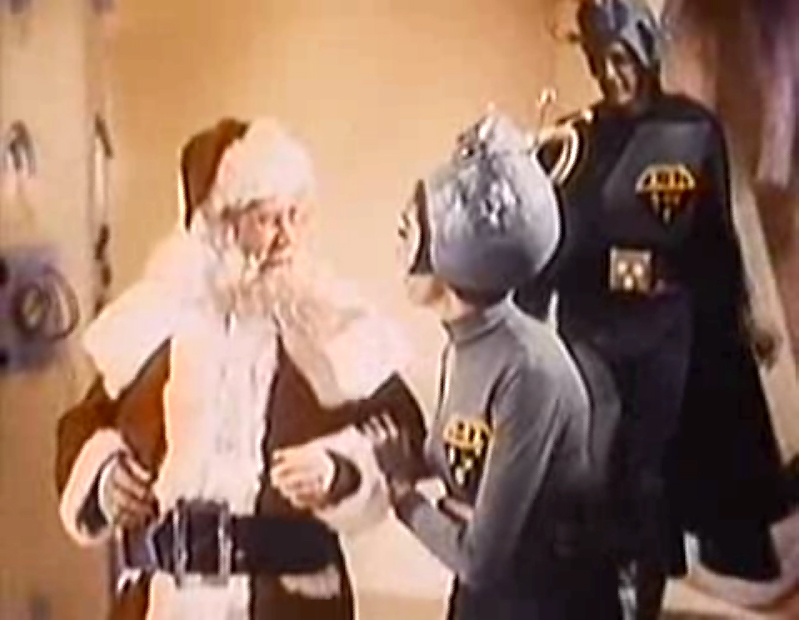 Thanks to Digg, we were able to spend a delightful Christmas morning watching Santa Claus Conquers the Martians. It just might be the best (read "worst") Christmas movie ever.
Thanks to Digg, we were able to spend a delightful Christmas morning watching Santa Claus Conquers the Martians. It just might be the best (read "worst") Christmas movie ever.
If you'd like to wash the taste of Martians out of your mouth, Jami's favorite Christmas story in the whole world, Christmas Every Day, is available as an mp3 on the Internet Archive. I can't recomend it enough. Here's a choice line, "Carts went around and gathered up all the candy and raisins and nuts, and dumped them into the river, and it made the fish perfectly sick." There are also present bonfires, and presents thrown through windows, and jokes involving pigs.
Posted by
Dane
at
9:16 PM
2
comments
![]()
Labels: holidays
23 December 2006
22 December 2006
21 December 2006
20 December 2006
Me and My Arrow
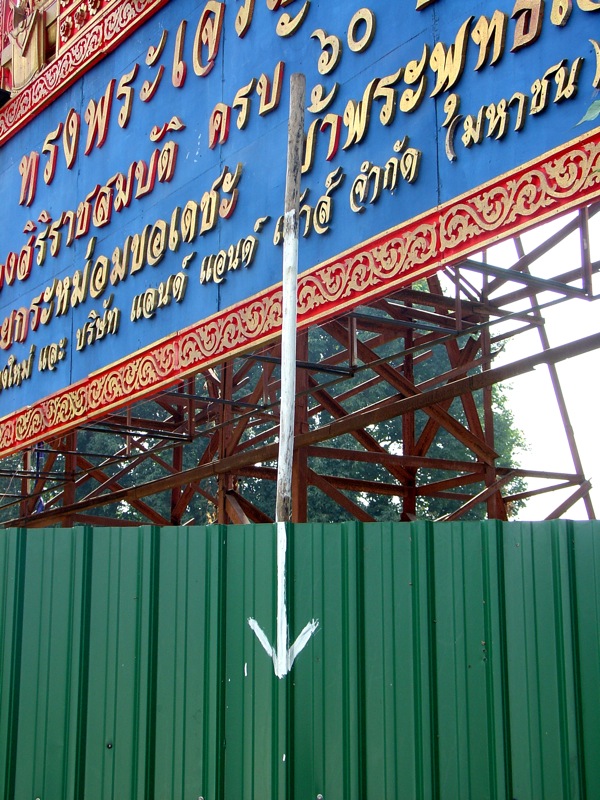 I pass this arrow on the way home from work. I like it because it's art-like, but isn't art. It may be really clever grafiti, but I think it's actually supposed to be useful somehow.
I pass this arrow on the way home from work. I like it because it's art-like, but isn't art. It may be really clever grafiti, but I think it's actually supposed to be useful somehow.
Posted by
Dane
at
5:29 AM
1 comments
![]()
Labels: art, Chiang Mai
17 December 2006
Just Around Back
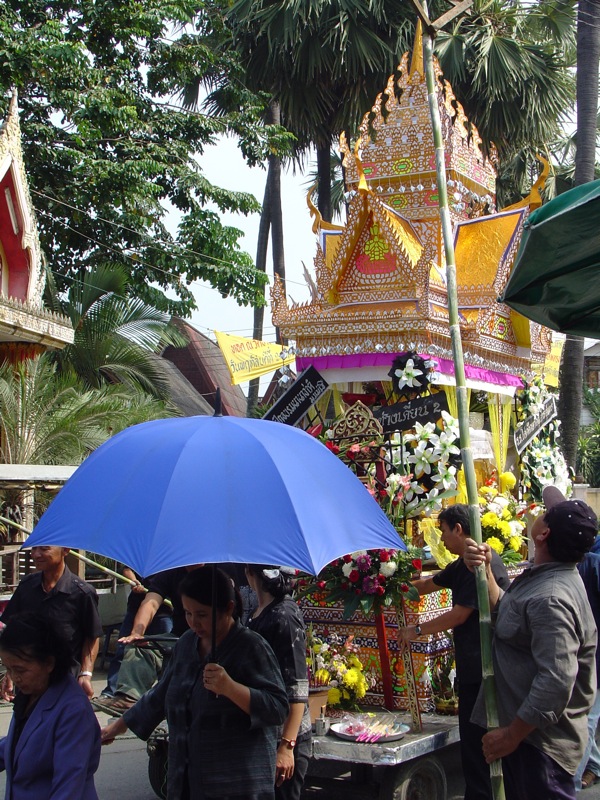
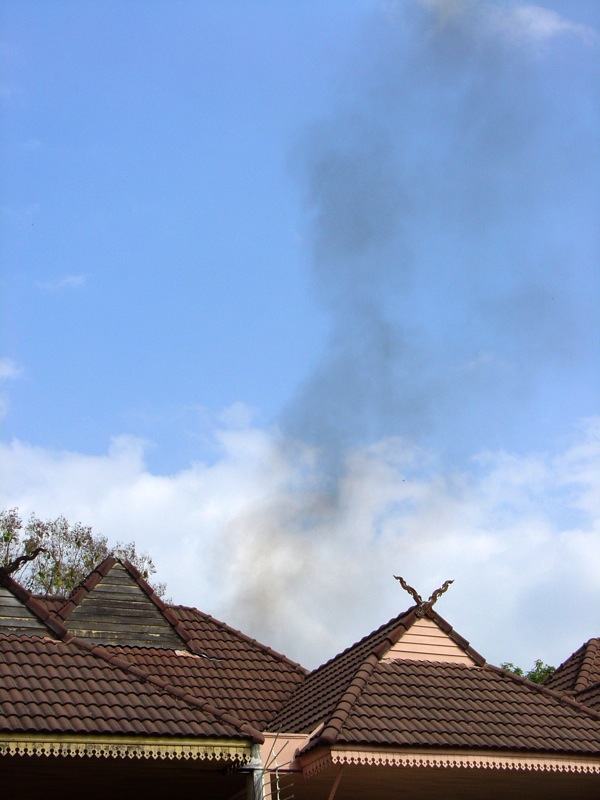 Near our house is a cremation grounds. I think of it as "just around back," but it's actually due east of us, which would make it "in front." We rarely see the smoke, but today we could, and it made me think of a funeral prcession we saw last month. The coffin/funeral pyre is pulled by ropes, which the whole party takes hold of. I have yet to see a pyre in the form of a flying elephant, though evidently they're quite popular.
Near our house is a cremation grounds. I think of it as "just around back," but it's actually due east of us, which would make it "in front." We rarely see the smoke, but today we could, and it made me think of a funeral prcession we saw last month. The coffin/funeral pyre is pulled by ropes, which the whole party takes hold of. I have yet to see a pyre in the form of a flying elephant, though evidently they're quite popular.
Posted by
Dane
at
8:40 AM
0
comments
![]()
Labels: Thailand
16 December 2006
Elroy Wolom
 9 x 9 x 9 x they say it's a hundred meters;
9 x 9 x 9 x they say it's a hundred meters;cotton yarn, Chinese ink, white glue; Reinhold Engberding; 2006
Last night we went to the opening of an exhibition of works by Reinhold Engberding, done during his stay here in Chiang Mai as part of a UNESCO grant. The exhibit, held in the diminutive "Yellow Room" (a side gallery off the main galleries, and source of the anagram tittling this post) of the Chiang Mai University Museum of Fine Art (a monsterous battleship of grey concrete with no permanent collection of its own), hosts two projects. One, entitled 9 x 9 x 9 x they say it's a hundred meters, consists of white fabric tubes, made from wrapped yarn, and graduated by one of Reinhold's personal measuring sticks--the length from his thumb to his forefinger. The marks were placed along the length of the yarn before it then was wrapped around trees of nine different species, and afterwards removed like a cast. Depending on the width of the trees, and regularity thereof, the marks created different patterns, ranging from helices, to scallops, to nearly random scatterings of dots. Accompanying the tubes are nine serigraphs of the leaves of each tree, done in white ink on unbleached saa paper, formated like botanical specimens, and labeled in Thai. Reinhold is a recovering landscape architect, much like I am a recovering gardener, and was pretty overwhelmed to find himself in an alien botanical context. Reaching out to the plants around him was an almost instinctual way of trying to orient himself in an unknown landscape. I find myself doing the same as I through our neighborhood, trying to come up with the genus, or at the very least the family, of the plants I see around me (Arum, Canna, Thalia dealbatana, Colocasia, Tectona grandis, Ficus religiosa, Agave americana, umm, umm, Bignoneaceae?)
The second project is of a series of interviews and reciprocal portraits done with Thai artists. Entitled How Are You?, the name is transliterated from a German idiomism (forgive me for latinizing, "idiomatic expression" is just so long) meaning, "What kind of person are you?" rather than, "How do you do?" Based on the questions asked, I would say that the real point of inquiry is actually, "How are you like me?" Several of the questions concerned the interviewee's knowledge of a foreign language (either English or Thai), their eating habits, their use of pseudonyms or nicknames, or the existence of an opposite gendered version of their name. All of these are of concern to Reinhold, either in his daily life in a foreign culture, or in his own artistic practice (see previous post). The artists then produced some sort of portrait of one another. Thailand seems to be the land of collaborative efforts, so it is interesting that Reinhold would choose here to take the step of enlisting other artists in the creation of his work, rather than just soliciting for material as he has done before in other community-based collaborations. Of course, this collaborative process, while no doubt rewarding, was also a source of frustration, as several artists failed to complete their interviews (in one of them only the first question was answered), or failed to complete their portraits. Though in the last case (that of a traditional woodcarver) the portrait in absentia inspired one of Reinhold's favorite text pieces, as yet untranslated into English, and perhaps untranslatable. That seems, at times, to be the boundary one walks as a foreign artist, the one between the untranslated and the untranslatable.

Posted by
Dane
at
3:55 AM
3
comments
![]()
Labels: art, artists, Chiang Mai
15 December 2006
Io Divento Raffi: Or How to Stay in a Country Who's Visa Laws Are in an Utter Shambles
 Witness My Reincarnation as Raffi.
Witness My Reincarnation as Raffi.With two weeks left before the Thai government kicks us out of the country for being artfags, lay-abouts, leeches, good-for-nothings, and suspected criminals, we are scrambling to secure our visas. Visas which will facilitate our continued presence as good-for-nothing artfags, and suspected criminals in residence. To do my part, I took a job singing The Alphabet Song, Mary Had a Little Lamb, and Twinkle Twinkle Little Star for two hours every morning at Nandachart Preschool. The same preschool Jami has been working at for the last two months.
I think the picture below pretty much sums up the whole experience. The jumping girl is called Ping Ping (two rising tones, so it sounds like she's about to blast off every time you say it).

Posted by
Dane
at
12:11 AM
2
comments
![]()
10 December 2006
Where Are We?
I don't know why it hadn't occured to me to do this earlier. The photo directly below is the old city of Chiang Mai, surrounded, as you can see, by its moat. Heading west/northwest from the northwest corner of the moat is a major road called Huay Kaew. You follow it west about a mile until you cross a road with a canal running down the middle.
 At the first break in the median after the canal road you turn right, and head north until the road dead ends after veering left somewhat. We're in the last town house on the left.
At the first break in the median after the canal road you turn right, and head north until the road dead ends after veering left somewhat. We're in the last town house on the left.
Umm. Please don't stalk us.
Posted by
Dane
at
11:19 AM
0
comments
![]()
Labels: Chiang Mai
04 December 2006
1 4m 0n m¥ 80x, G00g|1ng 4|| ur n4m3z
By now most of us have indulged in that onanistic satisfaction of curiosity known as "googling one's self." On that assumption I am initiating a project/experiment in which I attempt to find people merely by mentioning their names in this post.
Here are the names:
Shannon Crawford
Grant Gosler
Thomas (Tom) Hines
Jeff Jackson
Dixi Lee
Iñaki (Ignacio) López Ordóñez
George Martinez
George Moseley
Rocío Peña
Mathew (Matt) Poplawski or Poplowski
Graham Ross
Jenny Schlief (found herself on 14 December 2006)
Deewayne Sowels
James (Roy) Stanfield
I realize I could track down a number of these people through their own websites, their MySpace or Friendster accounts, my own friends and family, etc. That's not the point. The idea is to see if they can find themselves. The only help I would ask is that those of you with blogs or websites of your own link to the permalink for this post in order to increase its perceived relevance to Google.
To those of you on the list, hi. It's been a while. If you care to let me know that you've found yourself here, please leave a comment, or use the public email for this blog, which is: nofolete(at)gmail(dot)com.
Tangentially, I am adding two new categories to our del.icio.us account, "us" and "not_us" based on the Google results for "nofolete." A number of the results are from spammy and lamely redundant tag aggregating sites (most references coming from our Flickr or del.icio.us accounts). Since the links there are rather short lived I will ignore them and focus on the results that seem more permanent.
Posted by
Dane
at
7:33 PM
7
comments
![]()
02 December 2006
Escherichia coli
Would you rather:
a. suffer from severely dehydrating diarrhea?
b. vomit every two hours?
c. spend ten hours on a bus making an obligatory visa run?
d. all of the above?
Posted by
Dane
at
8:29 PM
6
comments
![]()
28 November 2006
Rêves Modernistes
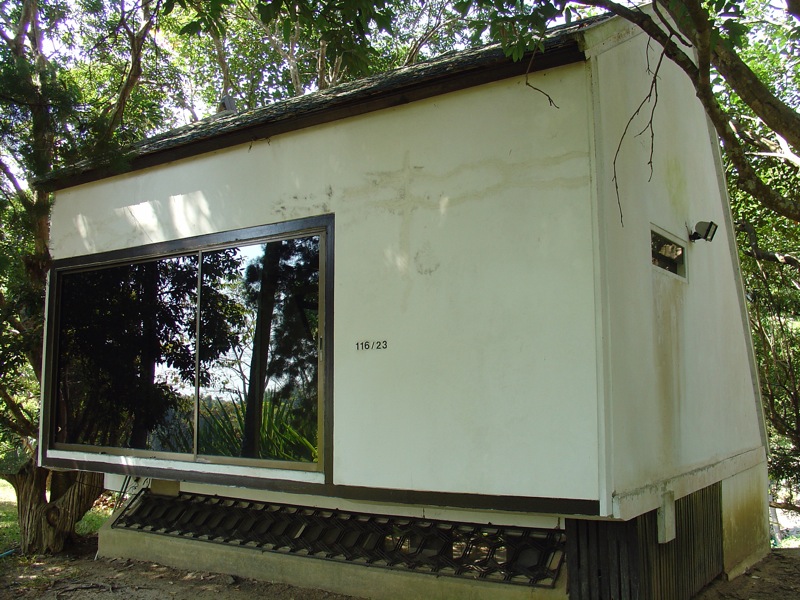
 Behind our house is a road that goes up the hill (actually the base of Doi Suthep Mountain) toward a Boy Scout camp. About halfway up the hill to the camp is a living fence of enormous (I'm talking eight feet tall) variegated Agave americana. We'd stopped before to take pictures of the of the agaves, and we also like the cottage just up the road from them which is done up to look like a Swiss or German timber frame house with plaster walls. On Monday we took an afternoon walk up to the falls at the Boyscout camp (one of the Boy Scouts let us climb the tower, which gave us a great view of the university behind our house), and on our way back down, while taking pictures of the goofy Swiss chalet, a gate that looked like it was made of old window sashes caught our eye. We stopped to take a picture, but never even got the camera out when we noticed the house behind it.
Behind our house is a road that goes up the hill (actually the base of Doi Suthep Mountain) toward a Boy Scout camp. About halfway up the hill to the camp is a living fence of enormous (I'm talking eight feet tall) variegated Agave americana. We'd stopped before to take pictures of the of the agaves, and we also like the cottage just up the road from them which is done up to look like a Swiss or German timber frame house with plaster walls. On Monday we took an afternoon walk up to the falls at the Boyscout camp (one of the Boy Scouts let us climb the tower, which gave us a great view of the university behind our house), and on our way back down, while taking pictures of the goofy Swiss chalet, a gate that looked like it was made of old window sashes caught our eye. We stopped to take a picture, but never even got the camera out when we noticed the house behind it.
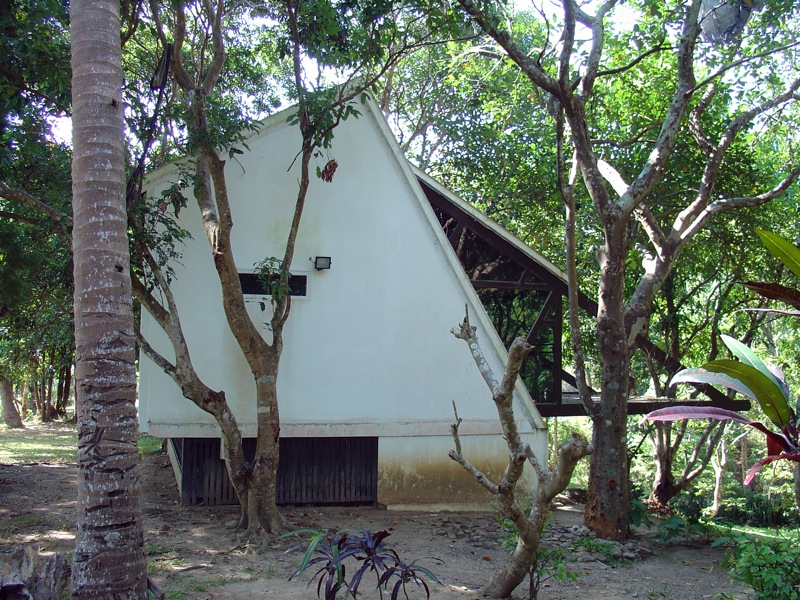
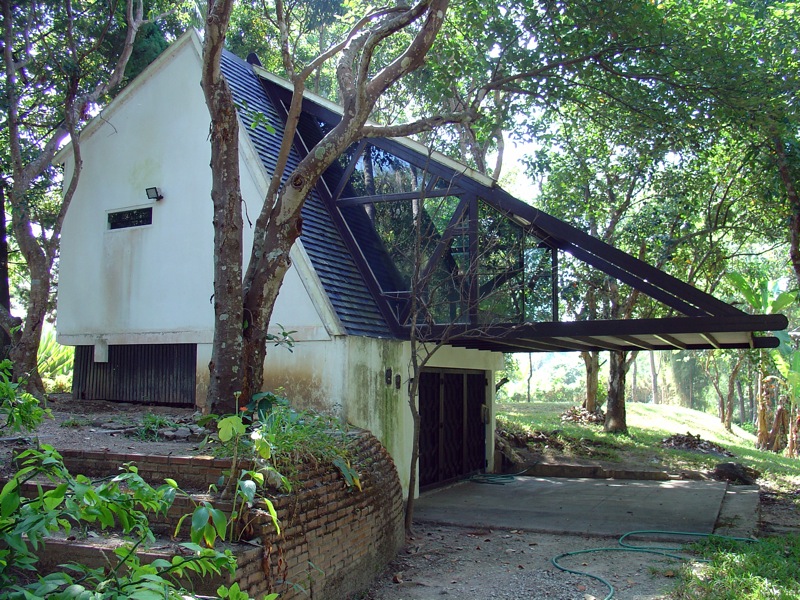
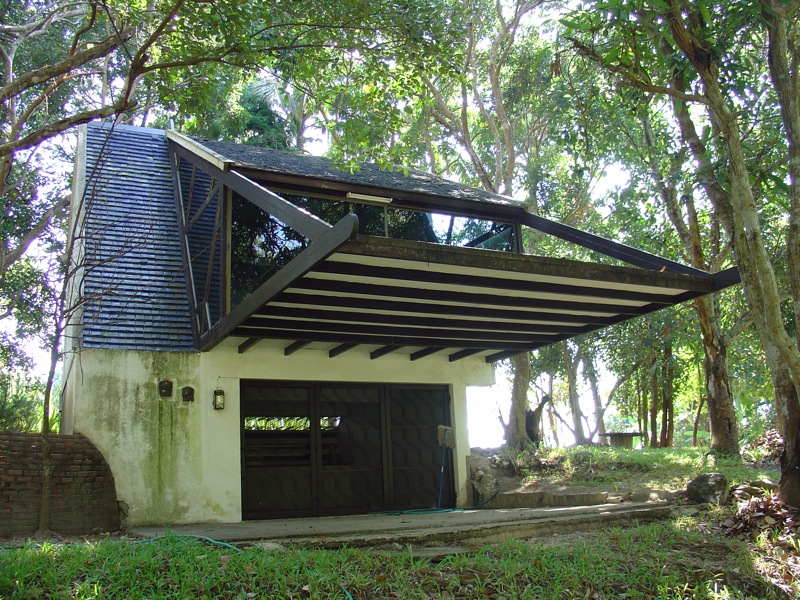 It is a tiny little modernist cabin, with a half-basement and a huge (nearly a third of the floor space on the main floor) cantilevered balcony. The kitchen is in the half-basement, with a bank of clerestory windows on the east side which tilts inward above the counter. The upper floor is a large open space with sliding doors on both sides, one opens onto the balcony, the other into the open air above the east wall of the kitchen. It's the only access to the main floor from the outside, and it's about a meter above ground, so there must be some missing stairs. The west side, with the balcony, overlooks the ravine carved by the creek that comes down out of the hills from the Boy Scout camp.
It is a tiny little modernist cabin, with a half-basement and a huge (nearly a third of the floor space on the main floor) cantilevered balcony. The kitchen is in the half-basement, with a bank of clerestory windows on the east side which tilts inward above the counter. The upper floor is a large open space with sliding doors on both sides, one opens onto the balcony, the other into the open air above the east wall of the kitchen. It's the only access to the main floor from the outside, and it's about a meter above ground, so there must be some missing stairs. The west side, with the balcony, overlooks the ravine carved by the creek that comes down out of the hills from the Boy Scout camp. The roof is done in blue glazed ceramic tiles. Unfortunately about a quarter of them appear to be in the yard. There doesn't seem to be any water damage inside, however--at least as far as we could see.
The roof is done in blue glazed ceramic tiles. Unfortunately about a quarter of them appear to be in the yard. There doesn't seem to be any water damage inside, however--at least as far as we could see.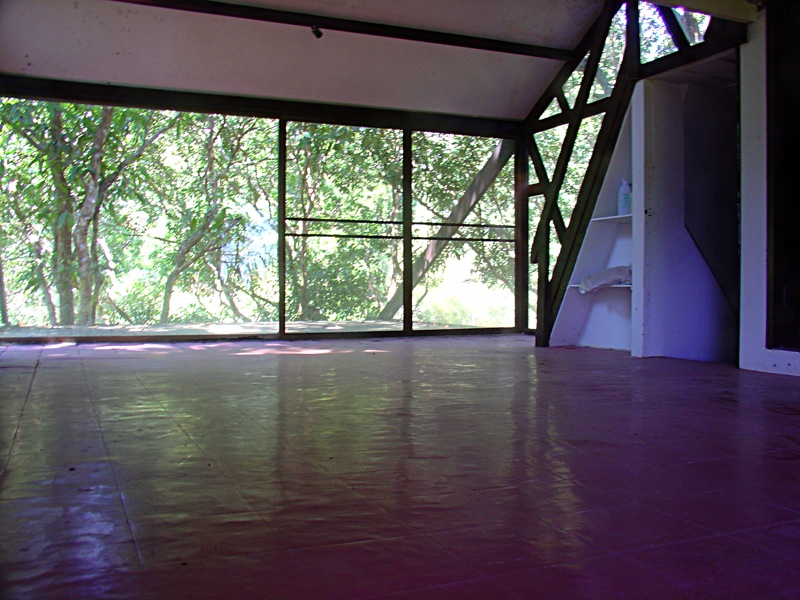
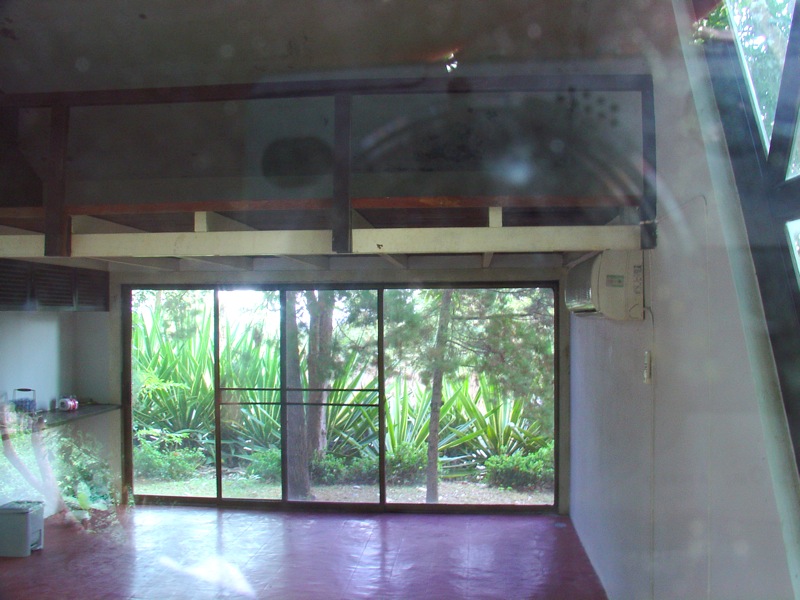 Covering nearly half of the floor space up top is a loft, ideally situated for a bedroom. It has a regular staircase leading up to it, so no falling off a ladder late at night when you're making a dash for the bathroom. Whoever designed the staircase, by the way, was brilliant. All its little nooks and crannies have been reclaimed for storage, with built-in shelves and little cupboards.
Covering nearly half of the floor space up top is a loft, ideally situated for a bedroom. It has a regular staircase leading up to it, so no falling off a ladder late at night when you're making a dash for the bathroom. Whoever designed the staircase, by the way, was brilliant. All its little nooks and crannies have been reclaimed for storage, with built-in shelves and little cupboards.Suffice it to say, every night since we saw it we've been falling asleep to modernist reveries. I even went and put a note on the gate begging to rent it.
Posted by
Dane
at
11:42 PM
9
comments
![]()
Labels: architecture, Chiang Mai
24 November 2006
A Gar-Man

 No, the title of this post does not refer to the man-fishy form of the image at top. Yesterday morning, while Jami was at work, a friend and I went to a lecture given by the German artist Reinhold Engberding, UNESCO artist in residence at Chiang Mai University. We'd met him during the CDSC design workshop, and happened to run into him again at the opening for the prototype exhibit last Friday, when he invited us to attend his lecture. He presented his own work, and also that of his two collaborators Holger B. Nidden-Grien and Bartole St. Strip. For those of you whose German might be a little rusty both names are anagrams (the title of this post is an anagram of "anagram" in fact--hope I'm not blowin' yer mind, man), Holger B. Nidden-Grien being an anagram of Reinhold's own name, and Bartole St. Strip being an anagram of Selbstportrait (self-portrait). His work could be characterized by the anagram, and other almost math-like or geometric operations performed on different objects or materials.
No, the title of this post does not refer to the man-fishy form of the image at top. Yesterday morning, while Jami was at work, a friend and I went to a lecture given by the German artist Reinhold Engberding, UNESCO artist in residence at Chiang Mai University. We'd met him during the CDSC design workshop, and happened to run into him again at the opening for the prototype exhibit last Friday, when he invited us to attend his lecture. He presented his own work, and also that of his two collaborators Holger B. Nidden-Grien and Bartole St. Strip. For those of you whose German might be a little rusty both names are anagrams (the title of this post is an anagram of "anagram" in fact--hope I'm not blowin' yer mind, man), Holger B. Nidden-Grien being an anagram of Reinhold's own name, and Bartole St. Strip being an anagram of Selbstportrait (self-portrait). His work could be characterized by the anagram, and other almost math-like or geometric operations performed on different objects or materials.
The first works he showed us were about the creation of a fictional (and incestuous) ancestry for Nidden-Grien, including photos of his parents (old photopraphs of civil servants found in second hand shops) and a pleasantly abstract family tree made of circles, with Nidden-Grien in the center. The next sculptures were large pieces crocheted from black cotton, like the ones at top, and filled with either inflated condoms (which are stronger than balloons, he says) or ping-pong balls. The shapes of the crocheted works are often dictated by the number of balls of yarn used, with either a hole, or a point, or some other change in the shape occurring where a ball ends. When I asked how long the crochet pieces take, he said about one ball a day. Many of the pieces contain 50 balls or more, so well over a month each. It's the perfect medium for a TV junkie, he says.
Other bodies of work, not shown here due to their absence on the web (these images, by the way, are all scrounged from various German language websites which you can reach by clicking on the photos), are three groups of self-portraits, collaborations with Bartole St. Strip. The first involved taking pictures of different parts his own head and reassembling them in a grid, but with the parts rearranged, or taking pictures of parts from slightly different angles so that the reassembled image comes out distorted. A second group combined his own childhood photos with pictures of children taken in a sanitarium. The third was a group done in collaboration with a village in which the work was exhibited. Villagers all roughly his age loaned childhood photos over which he placed (in Photoshop) a semitransparent layer of solid color, and then drew through that layer of color (using the erase tool) an image of himself at that age, revealing parts of the appropriated photograph beneath. This large and rather forlorn, felt teddy bear is related thematically to the sanitarium self-portraits, and I believe done around the same time.
This large and rather forlorn, felt teddy bear is related thematically to the sanitarium self-portraits, and I believe done around the same time.
Reinhold's most recent work, done during a residency in Bern, Switzerland, uses second-hand jackets. He finds two of roughly the same size and turns one sleeve inside out on each jacket, then inserts the inside out sleeves into the right side out sleeves, and sews the jackets together. The effect is rather like that of a gossip's seat (pictured below) made of jackets. Two men standing back to back can wear half a jacket each.
 Another piece, related to the jackets, is this group of vests, turned inside out and sewn together sleeve to sleeve. During his stay in Switzerland, Reinhold was able to visit the widow of one of his old professors. When she learned he was working with jackets she offered him several of her husband's old ones. Not sure he wanted to use material that was so personal, and so emotionally charged, he refused them at first. But upon her insistence he decided to use just the vests, and created what I think is a tactful and appropriate memorial.
Another piece, related to the jackets, is this group of vests, turned inside out and sewn together sleeve to sleeve. During his stay in Switzerland, Reinhold was able to visit the widow of one of his old professors. When she learned he was working with jackets she offered him several of her husband's old ones. Not sure he wanted to use material that was so personal, and so emotionally charged, he refused them at first. But upon her insistence he decided to use just the vests, and created what I think is a tactful and appropriate memorial.
Posted by
Dane
at
2:48 AM
1 comments
![]()
22 November 2006
18 November 2006
I'm Ready When You're Ready When I'm Ready: A Comedy in One Act
X- I'm ready when you're ready.
N- Umm. . .
Okay, ready.
X- . . . Just a second.
Posted by
Dane
at
3:36 AM
0
comments
![]()
Labels: incidental
15 November 2006
Silverpoint
I finally fixed our scanner. The AC adapter blew a fuse when I plugged it into a broken transformer. One of the great things about Thailand, it's cheaper to fix something than to buy a new one. 300 baht, about $8.50. Not bad.
So in celebration I've scanned all the silverpoint drawings I've done in the past few weeks.
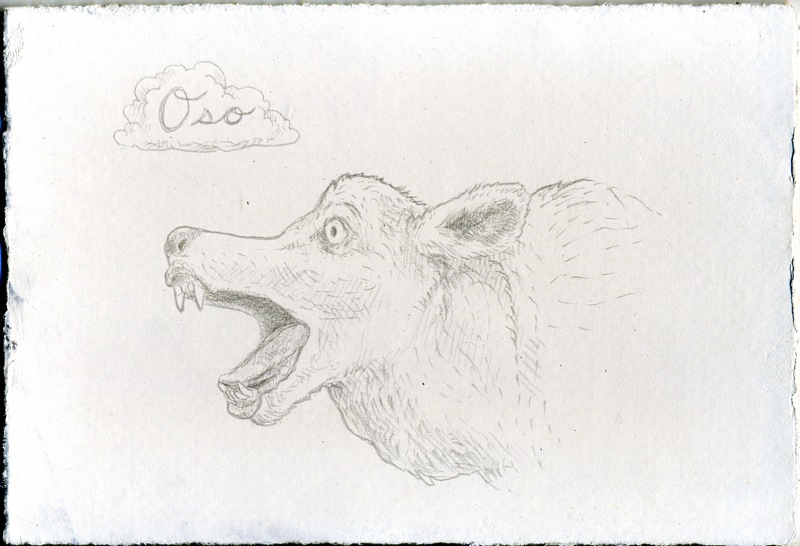 There is a restaurant near our house called Boat. They have a nifty wooden bear head up on one of the walls.
There is a restaurant near our house called Boat. They have a nifty wooden bear head up on one of the walls.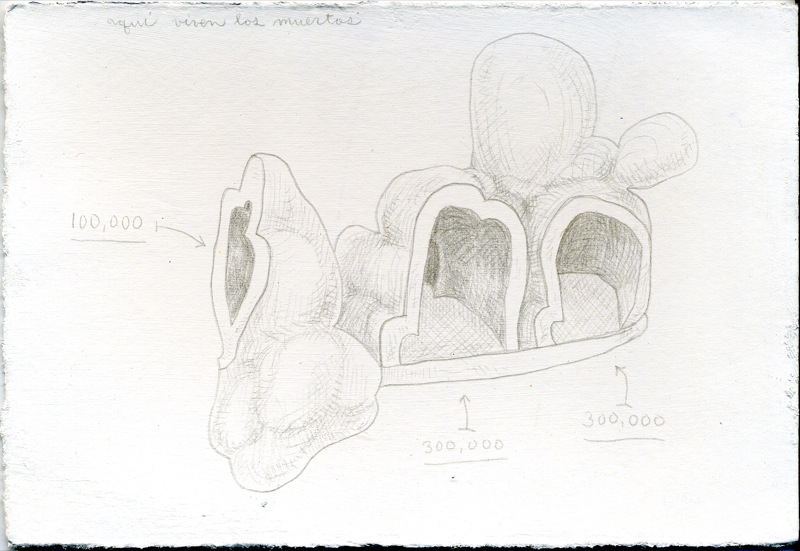 This is from an old drawing in one of my sketchbooks. While I drew it I was listening to an episode of This American Life about Iraqi deaths since the war.
This is from an old drawing in one of my sketchbooks. While I drew it I was listening to an episode of This American Life about Iraqi deaths since the war.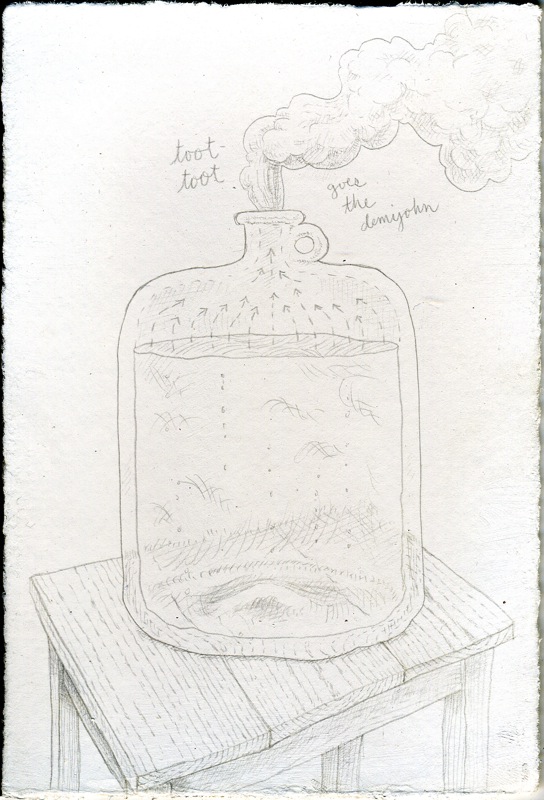 The original sketch for this one had text reading "demijohn full of guzzaleen," a reference to Tatyana Tolstaya's The Slynx. These are all for sale, by the way. If anyone's interested.
The original sketch for this one had text reading "demijohn full of guzzaleen," a reference to Tatyana Tolstaya's The Slynx. These are all for sale, by the way. If anyone's interested.
Posted by
Dane
at
9:07 AM
0
comments
![]()
Labels: art, things you can buy
